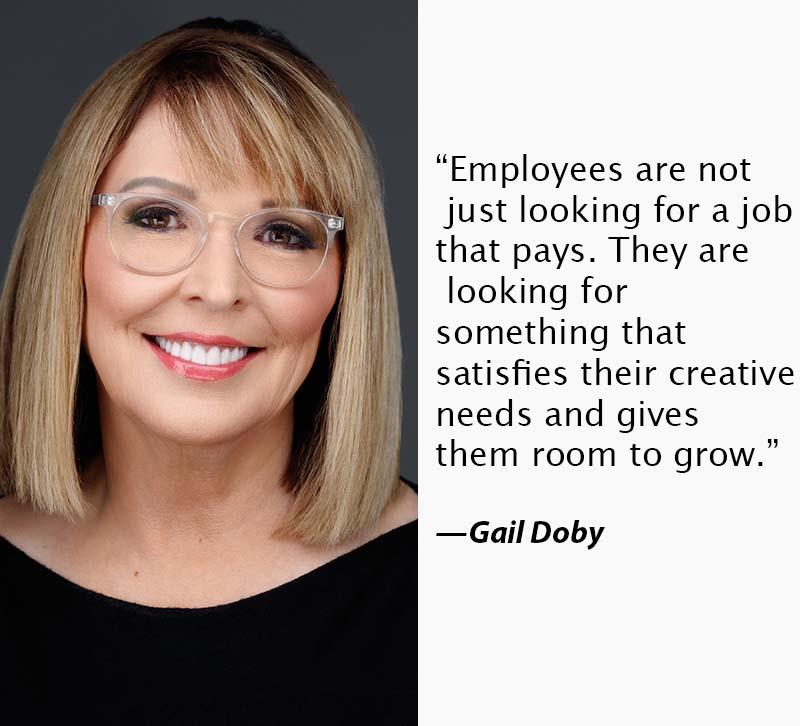Are you clear on your design business’s culture? According to Business Coach Gail Doby, whether you’re a solopreneur or you run a team of 20, a defined culture is an important step toward creating growth in your business. A company’s culture is defined by its leaders. Any business culture should be authentic to its owners and modeled by them as well.
Particularly, if you are hiring for your business, your company needs to have clear values and direction for new and existing employees. “Culture is an emotional connection, and you have to have that emotional connection and deeper values to create a deeper bond with your employees,” Doby says. “Those values, authentic to the owner, determine how team members and clients are treated. It’s important to remember that your employees are your number one client, and it’s so important to treat them right.”
In today’s hiring landscape, where employees have more options, many are looking for more than money. “Salary is important, but it’s not as important as a fit with the culture,” Doby continues. “Companies need to have their purpose and philosophy nailed down. People are not just looking for a job that pays. They are looking for something that satisfies their creative needs and gives them room to grow.”
With younger generations particularly, they want a career where they understand their growth path and can be challenged, she adds. These potential employees want to understand how an employer embodies and shares its culture, and empowers its people.
Doby speaks from experience. In her first company, she “made every mistake in the book,” she says. She felt like she was fighting her employees rather than connecting. One thing she learned was that instead of hiring someone to fit a specific position, it was important to understand that person’s talents, and work to train, support and mentor them to excel in that role and beyond. “People have talents that sometimes they don’t even know they have,” she notes.
Achieving this with staff requires understanding the culture of your business first, and it’s one of the foundations of Doby’s coaching focus. Today, she understands the importance of the criteria behind values and culture in a business. “I didn’t understand this in my first company, which made it challenging,” she says. “I didn’t have the criteria for how to select and how to let go.” She has command of this in her current businesses, and she helps her clients understand the need for a defined culture as well.
Pass It Forward
Beyond understanding your business culture, processes have to be developed to ensure everyone in the organization acknowledges and speaks from the same place. You need consistent, clear communication, Doby says. “Training is more than just teaching someone tasks,” she adds. “The culture has to be part of the training process. Employees need to feel valued; employers need to understand the desire and aspirations of the people they are bringing on board.
“Your culture statement is something your employees are comfortable saying about you as a friend. They need to believe you are the embodiment of your culture,“ she continues. To ensure employees embrace the culture of your design firm, there are several processes you, as the owner, can commit to.
First, the culture of your company needs to be modeled by you. “When we have our whole team together now, we are always talking about our culture,” Doby says, adding that there are a few key things owners can do to ensure employee understanding and engagement of that culture. Your employees are often front-facing with clients, so that cultural perspective is integral to them representing your firm in the right way.
What can you do to help your employees embrace your values and feel a part of the culture? Have regular meetings with your team. This can be tricky when busy, but consistent meetings are essential to sharing clear values. Treat your team with the utmost respect. They are there to serve your clients and you don’t want them frustrated. “A happy employee is clear about expectations and knows their employer has their back,” Doby shares. Know your employees’ talents and who they are on the inside as well. Recognize accomplishments.
Have a give-back component in your company culture, focused on charitable activities or philanthropic projects, and get your employees engaged in that contribution.
To be financially successful in your design business, it’s essential to have employees who embrace your culture and bring that to your clients. Today’s hiring environment is more competitive than it’s been in a long time. Hiring, onboarding and retaining good employees can make the difference in your business. Being clear on you and your company’s culture and taking the steps to ensure your employees embrace that as well can be the key to a happy, successful work environment.
About Gail Doby
Gail Doby is Principal of Gail Doby Coaching and Consulting and author of the recently published Business Breakthrough: Your Creative Value Blueprint to Get Paid What You’re Worth.
With her team, she’s helped more than 10,000 designers in 76 countries achieve their goals. The designers she’s worked with in her VIP Experience program are doubling, tripling (and more) their businesses… with clarity and confidence. “The truth is when you understand how to remove what is standing in your way of having everything you want…you won’t hesitate anymore. You will be on fire,” Doby says.







